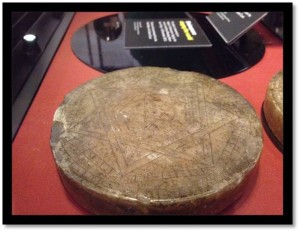On my recent trip to the UK, I purposely planned to spend unimpeded time in the medieval halls of London’s British Museum. While I’ve visited the museum on previous trips, I’ve always been with other people preventing the opportunity to ‘wander’ to my heart’s content. This time I did and was in ‘hog heaven’ as we say in the Midwest.
So many unexpected delights made up my afternoon that the time spent was even richer than I’d hoped. For example, months ago I’d planned to take the train north for a day to visit ‘The Staffordshire Hoard’which is on display in Birmingham’s Museum of Art. However, by the time I actually got to London, I’d changed my planned itinerary so many times that Birmingham was no longer possible. Little did I realize that I really wasn’t going to miss out due to the fact that the BM houses many, many stunning artifacts from other ‘hoards’ including the famous one discovered at Sutton Hoo.
While I could blog pages on all of the wonderful things I saw in just four hours’ time, of particular interest regarding my 12th century historical mysteries, was the museum’s ‘Hands On’ exhibit hall. In this hall which is extensive, patrons have the opportunity to get ‘up close and personal’ with artifacts covering a myriad of interests, time frames and cultures, with the assistance of museum personnel. I couldn’t believe they actually allow photography as well! All I could think was, if I tried to photograph something in Chicago’s Field Museum, I most likely would be severely cautioned to “cease and desist” at the very least!
In any case, it was in this ‘hall’ that I came across some ‘tools of the trade’ belonging to Queen Elizabeth I’s famous conjurer, Dr. John Dee (1527-1608/09), which according to the museum’s information, were acquired by the ‘antiquary and collector’, Sir Robert Cotton. Descriptions of those photos which I’ve posted here are as follows…
“The large wax disc, called the ‘Seal of God’ is engraved with magical names and symbols. Dee used it as a support for his ‘shew-stones’, in which his medium allegedly saw visions of divine beings unveiling the secrets of the universe. The two smaller discs (not pictured) are said to have supported Dee’s ‘Table of Practice’. The golden disc is engraved with the so-called ‘Vision of the Four Castles.’ The black obsidian mirror, originally a Mexican Aztec cult object, was used for conjuring up spirits.”
Although these ‘wondrous things’ (to quote Lord Carnarvon when he first peeked into Tutankhamen’s tomb) are roughly 400 years after the time frame I write in, one can’t resist being be dazzled when standing in front of them!
Photography©Gaye F. Mack, Inc.


